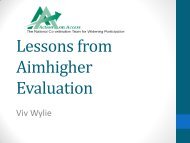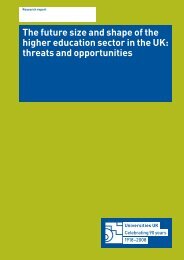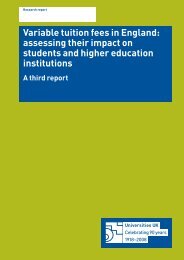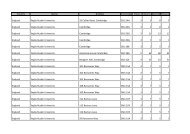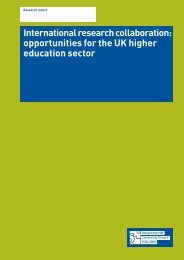Part-time Students And part-time Study In Higher ... - Universities UK
Part-time Students And part-time Study In Higher ... - Universities UK
Part-time Students And part-time Study In Higher ... - Universities UK
You also want an ePaper? Increase the reach of your titles
YUMPU automatically turns print PDFs into web optimized ePapers that Google loves.
3.3.2 Average total study costs paid by students out of their own pocketTables 3.8 and 3.9 give an indication of the average total costs involved in studying <strong>part</strong>-<strong>time</strong>. Bycontrast, Tables 3.10 and 3.11 show how much students personally paid, out of their own pockets,for their studies.• <strong>Students</strong>, incurring tuition fees and other study costs, paid an average of £951 out of their ownpocket for their <strong>part</strong>-<strong>time</strong> course over the academic year. A quarter spent £320 or less, a halfpaid under £730 and a half more than this sum, while a quarter had costs of £1,337 or more(Table 3.7).• These amounts may be a little lower than expected, but it should be recalled that two in fivestudents paid no fees at all.• Tables 3.10 and 3.11 show how these total study costs varied by students’ key characteristicsand the nature of their course. The students who personally had to pay the most for their <strong>part</strong><strong>time</strong>studies expected their course to last 4 years while those paying the least out of their ownpockets were taking a course that did not lead to a qualification.• Those student groups incurring the highest costs, at least £100 above the average, includedstudents:− who expected their course to last for four years – average costs £1,260;− who already had a post graduate degree before starting their current course –average costs £1,099;− who were taking 75 per cent or more of a full-<strong>time</strong> course – average costs £1,073;and− 60-74 per cent of a full-<strong>time</strong> course – average costs £1,056.• These student groups, who have to pay the largest sums out of their own pocket, are slightlydifferent from the student groups with the highest fees (sections 3.1.1) and total study costs(section 3.3.1).• <strong>In</strong> addition, these groups are to some extent inter-related. Of those students who expectedtheir course to last 4 years, 30 per cent were taking courses 75 per cent of a full-<strong>time</strong> coursewhile this was the case for just 20 of all students with such workloads.• Those students with the lowest total study costs paid for out of their own pocket, at least £100below the average, were:− taking a course that did not lead to a qualification – average costs £590;− on a short course lasting one year or less – average costs £595;− taking an ‘other’ undergraduate qualification – average costs £688;− on a course lasting 2 years or 3 years less – average cost £728 and £843;− on a distance learning course – average costs £713; and− taking a sub-degree course including a foundation degree, HNC/NHD, DipHE/CertHE– average costs of £798.• There is more of an overlap between the student groups incurring the lowest fees and thoseincurring the lowest total study costs. As we have seen in relation to tuition fees (section<strong>Part</strong>-<strong>time</strong> students and <strong>part</strong>-<strong>time</strong> study: Strand 3 <strong>Universities</strong> <strong>UK</strong> 41




